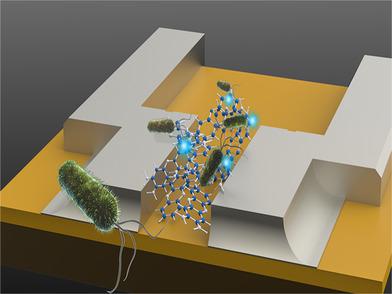当前位置:
X-MOL 学术
›
Electroanalysis
›
论文详情
Our official English website, www.x-mol.net, welcomes your
feedback! (Note: you will need to create a separate account there.)
Conjugated Molecule Based Sensor for Microbial Detection in Water with E. coli as a Case Study and Elucidation of Interaction Mechanism
Electroanalysis ( IF 2.7 ) Pub Date : 2018-03-14 , DOI: 10.1002/elan.201800052 Ashwini N. Mallya 1 , Praveen C. Ramamurthy 1
Electroanalysis ( IF 2.7 ) Pub Date : 2018-03-14 , DOI: 10.1002/elan.201800052 Ashwini N. Mallya 1 , Praveen C. Ramamurthy 1
Affiliation

|
Water testing for microbial contamination is essential to ensure safe drinking water. In the present work, an organic nanocomposite based sensor is designed and fabricated to detect the presence of E. coli in water. The detection is carried out by measuring the change in two parameters of the organic nanocomposite film - resistance and impedance. The lower detection limit of E. coli cell counts up to 10CFUmL(-1) and 10(7)CFUmL(-1) in 100mL test solution is observed by impedance spectroscopy and resistance change respectively. A conjugated molecule with a specific pendant amine group was used as the receptor moiety that can interact and exhibit affinity to the functional groups like carboxyl groups present on the outer membrane of the cell wall of the E. coli. The binding of E. coli cells to conjugated molecule was characterized by chemical, physical and structural properties. The electrostatic interaction between positively charged amine groups on conjugated molecule and negatively charged E. coli is utilized for sensing. This interaction is also observed to be acting as p-dopant to conjugated molecule which synergistically induces a change in electrical resistance in the composite. This work shows that the conjugated molecules designed with suitable moieties could be used for sensing microorganisms, when most sensors for detection of E. coli cells, use antibodies as detecting element.
中文翻译:

基于共轭分子的传感器以大肠杆菌检测水中的微生物作为案例研究并阐明相互作用机制
微生物污染的水测试对于确保安全的饮用水至关重要。在目前的工作中,设计并制造了一种基于有机纳米复合材料的传感器来检测水中大肠杆菌的存在。通过测量有机纳米复合薄膜的两个参数——电阻和阻抗的变化来进行检测。通过阻抗谱和电阻变化分别观察到100mL试液中大肠杆菌细胞计数的检测下限高达10CFUmL(-1)和10(7)CFUmL(-1)。具有特定侧胺基团的共轭分子用作受体部分,该部分可以与大肠杆菌细胞壁外膜上存在的官能团(如羧基)相互作用并表现出亲和力。大肠杆菌细胞与偶联分子的结合通过化学、物理和结构特性。共轭分子上带正电荷的胺基团与带负电荷的大肠杆菌之间的静电相互作用用于传感。还观察到这种相互作用对共轭分子起到 p 掺杂剂的作用,协同诱导复合材料中电阻的变化。这项工作表明,当大多数用于检测大肠杆菌细胞的传感器使用抗体作为检测元件时,设计有合适部分的偶联分子可用于感测微生物。还观察到这种相互作用对共轭分子起到 p 掺杂剂的作用,协同诱导复合材料中电阻的变化。这项工作表明,当大多数用于检测大肠杆菌细胞的传感器使用抗体作为检测元件时,设计有合适部分的偶联分子可用于感测微生物。还观察到这种相互作用对共轭分子起到 p 掺杂剂的作用,协同诱导复合材料中电阻的变化。这项工作表明,当大多数用于检测大肠杆菌细胞的传感器使用抗体作为检测元件时,设计有合适部分的偶联分子可用于感测微生物。
更新日期:2018-03-14
中文翻译:

基于共轭分子的传感器以大肠杆菌检测水中的微生物作为案例研究并阐明相互作用机制
微生物污染的水测试对于确保安全的饮用水至关重要。在目前的工作中,设计并制造了一种基于有机纳米复合材料的传感器来检测水中大肠杆菌的存在。通过测量有机纳米复合薄膜的两个参数——电阻和阻抗的变化来进行检测。通过阻抗谱和电阻变化分别观察到100mL试液中大肠杆菌细胞计数的检测下限高达10CFUmL(-1)和10(7)CFUmL(-1)。具有特定侧胺基团的共轭分子用作受体部分,该部分可以与大肠杆菌细胞壁外膜上存在的官能团(如羧基)相互作用并表现出亲和力。大肠杆菌细胞与偶联分子的结合通过化学、物理和结构特性。共轭分子上带正电荷的胺基团与带负电荷的大肠杆菌之间的静电相互作用用于传感。还观察到这种相互作用对共轭分子起到 p 掺杂剂的作用,协同诱导复合材料中电阻的变化。这项工作表明,当大多数用于检测大肠杆菌细胞的传感器使用抗体作为检测元件时,设计有合适部分的偶联分子可用于感测微生物。还观察到这种相互作用对共轭分子起到 p 掺杂剂的作用,协同诱导复合材料中电阻的变化。这项工作表明,当大多数用于检测大肠杆菌细胞的传感器使用抗体作为检测元件时,设计有合适部分的偶联分子可用于感测微生物。还观察到这种相互作用对共轭分子起到 p 掺杂剂的作用,协同诱导复合材料中电阻的变化。这项工作表明,当大多数用于检测大肠杆菌细胞的传感器使用抗体作为检测元件时,设计有合适部分的偶联分子可用于感测微生物。











































 京公网安备 11010802027423号
京公网安备 11010802027423号